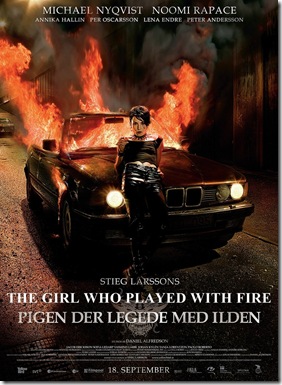In The Girl with the Dragon Tattoo, we first met researcher/hacker Lisbeth Salander [Noomi Rapace] and crusading journalist Mikael Blomkvist [Mikael Nyqvist] as they investigated the niece of a Swedish business giant. Now they’re back and trying to prove that Salander hasn’t committed three execution-style murders.
The Girl Who Played with Fire is a strange and beautiful Swedish thriller that, like its predecessor, has to cut to the heart of a complex and detailed novel to present the core of that novel in such a way as to hit all the important character and story beats without forcing the audience into a daze.
The film has its beginnings in two key points: Salander’s supervisor [she’s been made to appear mentally incompetent] has gone to contact called Zala to have her killed and a DVD of his rape of her destroyed; a young journalist comes to Millennium Magazine with a story on human trafficking – and he and his girlfriend are murdered. Because of certain circumstances that become clear later in the film, the Supervisor, Nils Bjurman [Peter Anderrson] winds up dead, as well. All three murders are set up to make Salander look guilty.
Like its predecessor, Fire doesn’t connect Blomkvist and Salander, physically, until late in the film’s dying moments. Each carries out their own independent investigation and a curious connection leads to brief communications via computer. Blomkvist gets some very little assistance from a plodding cop named Bublanski [Johan Kylen in a role that much bigger in the book].
Drawn into what is still a pretty complex – and rewarding – film are Miriam Wu [Yasmine Garbi], Salander’s sometime lover and victim of an identity mix-up; Paolo Roberto [Paolo Roberto] as Salander’s one-time sparring partner [she boxes!]; Zala [Georgi Stakov], and the hulking Ronald Niedermann [Mikael Spreitz], a giant whose inability to feel pain causes Salander much grief.
Daniel Alfredson directs Jonas Frykberg’s script with a deliberate touch. This is not a thriller because of the action, though there is some pretty intense action, but because the main characters are on a collision course that becomes more and more obvious as the film progresses. It’s like watching from the top of a hill as two cars speed toward an uncontrolled intersection – they can’t see each other and so have no awareness of the danger, but you can see everything.
As with the first film in the series, there have been changes above and beyond the cuts required to keep the film from going on for days. Most of these changes are required to make those cuts work, but the one big change is that the film has an ending rather than a cliffhanger, like the novel. That makes for a more rewarding movie experience and it should still be easy enough to move into the third film [coming to a theater near you in the fall].
While the entire cast is super, the film lives or dies on the performances of Nykvist and Rapace. Nyqvist keeps Blomkvist’s emotions to himself, allowing things to flicker across his face when things get tense, just as Rapace maintains Salander’s sullen pose while allowing her inner fire flare up behind her eyes – a fire that gives her a strength that belies her diminutive stature.
Before the American adaptation of The Girl with the Dragon Tattoo has even finished shooting, all three of the Swedish Millennium films will have played here. The second in the series, The Girl Who Played with Fire, lives up to the first in terms of writing, direction and performance.
If you love Stieg Larsson’s Millennium books, you owe it to yourself to see their Swedish adaptations. After seeing what Noomi Rapace does with the role of Lisbeth Salander, I can’t see anyone else portraying her as well.
Final Grade: A+
